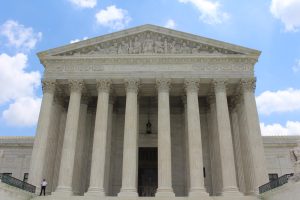Every summer Population Education is fortunate to host interns from around the U.S. These students bring their talents and passions to the PopEd program by completing a wide variety of projects. The following blog was written by one of PopEd’s 2023 summer interns.
On Thursday, June 29th, 2023, the Supreme Court struck down affirmative action admissions policies at Harvard College and the University of North Carolina as unconstitutional under the Constitution’s Equal Protection Clause. The Supreme Court decision for Students for Fair Admissions, Inc. v. President and Fellows of Harvard College overturned the 2003 ruling Grutter v. Bollinger, which allowed race to be considered as a factor for maintaining diverse higher education campus environments.
Youth activists, university leaders, and public officials alike have spoken up on the critical consequences the Supreme Court’s decision could have for public and private higher education and diversity in teaching education programs. Just as affirmative action leads to diversity in college and university enrollment, it also leads to diversity in employment sectors. How will losing affirmative action affect the diversity of teachers in K-12 schools? And what impacts will this potential loss of diversity have on an ever-more-diverse body of students?

Educational Equity and Affirmative Action’s Impact on Students of Color
Students of color have long endured systemic barriers of exclusion, segregation, lower funding, fewer resources, and lower family income in their education, workplace, and beyond. Students of color are less likely to have access to preparatory schools, tutors, or other educational assistance tools to prepare them with higher test scores or shining college applications. Their white, often wealthier, counterparts are more likely to have a parent that attended college, giving them a leg up with greater college preparation and, sometimes, legacy admissions.
By addressing systemic biases and leveling the playing field, affirmative action seeks to create a society where opportunities are not limited by one’s race, gender, or ethnicity. Rather, it allows colleges and universities to practice a more holistic and equitable approach to admissions.
Affirmative Action Advantages for All Students
However, affirmative action doesn’t just benefit people of color. All students benefit from student diversity on campus and in classrooms. Studies performed by the Century Foundation show that racially diverse classrooms can reduce students’ racial bias, improve satisfaction and intellectual self-confidence, and enhance leadership skills for all students.
Implications of Reduced Teacher Diversity

Looking further into the education field, the lack of targeted initiatives to promote diversity could result in fewer minority teachers being hired or retained in schools. This, in turn, might lead to a less diverse teaching staff, which could have several outcomes.
One of the primary implications of reduced teacher diversity is the impact on representation. Research has shown that students of color often benefit from teachers with similar backgrounds, leading to a potential achievement gap widening if teacher diversity decreases. A diverse teaching staff can also enhance educators’ cultural competency, allowing for better understanding and communication with students from diverse backgrounds and perspectives.
The impact of repealing affirmative action on teacher diversity may vary depending on state diversity policies and local school district practices. Some states or institutions may continue prioritizing diversity and inclusion without formal affirmative action policies. Others may not, leading to disparities in teacher representation and its effects on students’ educational experiences and opportunities.
In recent decades, the percentage of teachers of color in the U.S. has grown (from 13 percent in 1990 to 20 percent in 2015), but has still not kept pace with the percentage of students of color in American classroom, which is now over 50 percent. And, as a whole, teacher preparation programs are still less diverse than higher education as a whole.
Concerns after Affirmative Action Repeal
 The repeal of affirmative action admission policies raises concerns about the consequences of diversity in higher educational institutions and teaching professions. Before the repeal, affirmative action played a crucial role in providing equitable opportunities for students and teachers of color, but its elimination may exacerbate existing educational disparities.
The repeal of affirmative action admission policies raises concerns about the consequences of diversity in higher educational institutions and teaching professions. Before the repeal, affirmative action played a crucial role in providing equitable opportunities for students and teachers of color, but its elimination may exacerbate existing educational disparities.
In the past year, many elite universities have enhanced their financial aid offerings in an effort to maintain economically diverse classrooms. Many universities have also made public statements to assure and emphasize their mission of creating diverse classrooms to the extent that the law allows. However, it is possible that looking at family income alone will not close the gaps left widened by the overturning of affirmative action. The effects of the recent court decision and how institutions of higher learning respond may have far-reaching impacts for students of color for generations to come.
Image credits: Elementary students at desks (Photo by Kenny Eliason on Unsplash), Young students reading together (Photo by CDC on Unsplash), Supreme Court building (Photo by Claire Anderson on Unsplash)


